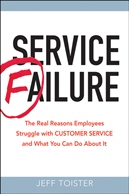How do you decide when to cut your losses with a poor performer?
 Jeff Toister
Jeff Toister  Tuesday, January 19, 2010 at 7:28AM |
Tuesday, January 19, 2010 at 7:28AM | A colleague of mine in Washington D.C., Hallely Azulay, tweeted (@HalellyAzulay) a deceptively simple question this morning:
Sometimes U can reform a poor performer + sometimes U have 2 cut yr losses + start from scratch. How do *U* decide which way 2 go?
I've had the fortune (or misfortune) to come about my answer the hard way - through trial and error experience. Years ago, I was a training supervisor for two large call centers at Chadwick's of Boston. Our HR department was judged by how many people they hired, regardless of qualification, so we received lots of new hires who couldn't do the job. My department was judged by whether or not the people who graduated our new hire training program could do the job. I was the hatchet man who had to fire people who weren't going to make it. I hated that aspect of the job, so I learned how to ensure that the only time I fired someone was because it was the last resort and the right thing to do.
I start by asking three questions:
|
Yes |
No |
|
| Is the person aware of the desired performance? | See next question. | Make sure they know what is expected! It seems obvious, but until you confirm they know what is expected it's tough to hold someone accountable. |
| Is the person aware their performance needs to improve? | See next question. | Give them honest and direct feedback. I've seen a lot of passive aggressive managers try to dodge this one by dropping hints or venting about the person. |
| Is the person willing to perform at the desired level? | See next question. | Cut your losses. This isn't a good fit for you or them. |
Now, it gets tricky. They know what to do, aren't doing it, but are willing to keep trying. Here's my general approach:
Step 1: The initial conversation.
Have a conversation with the person to strategize on to get their performance up to speed. The person ultimately has to take ownership, but make it clear you are there to help. Sometimes, the result of this conversation is the person decides the role isn't a good fit for them after all. It's a tough decision, but it's theirs.
Step 2: Let them fail.
If Step 1 doesn't work it's time to remove the safety net, the training wheels, or whatever else is propping up this person's performance. They need to be completely on their own and experience the struggle of trying to perform. Letting them fail generally results in the person deciding the role isn't right for them (again, their decision) or realizing what it truly takes to succeed. In rare cases, the person fails but doesn't have an epiphany, which means it's on to Step 3.
Step 3: Cut your losses.
This step is truly the hard part, but it needs to be done. You've given them every chance to succeed, but they've demonstrated they are not going to and are struggling to realize they can't. It's now time to make the decision for them and move them along.




Reader Comments (1)
Thanks for blogging my tweet, Jeff! It is deceptively simple, isn't it. You pose a good decision making matrix that is helpful.
This is a very tough challenge, especially when variables factor in such as:
- How long have you observed the lagging performance and was there any contrary evidence available (in other words, are they new to the role and underperforming or have they performed well in the past and their performance has declined over time)
- How critical is their function and how much wiggle room do you have to wait until they improve over time or try and fail (sometimes you can't afford to let a critical function fail - it has negative organizational ramifications too steep to withstand)
- What are the long-term implications of the turnover cycle - how negatively will a drawn-out-but-failed reform effort affect business results and customer satisfaction, versus the negative implications of re-entering the sourcing/recruiting cycle earlier than later?
It's never clear cut. There is no one right way. Performance management is contextual and complex, huh?